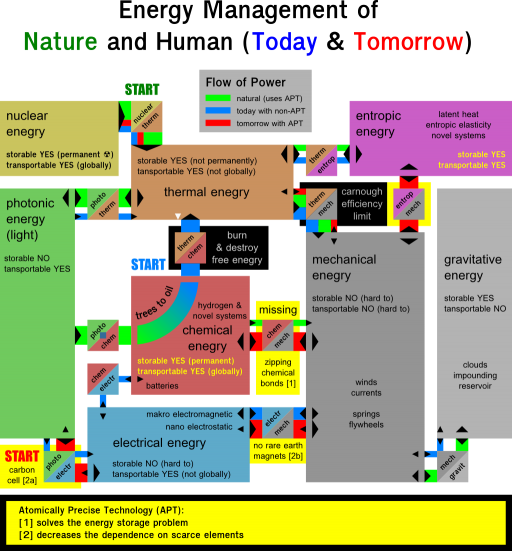Energy storage problem
Contents
State of the art
Today (2015) humankind still mainly uses fossile fuel for energy. In europe regenerative energy sources are on the rise and already provide some noticeable fraction of the energy. Regenerative energy faces several problems though. The main one is that current non atomically precise technology isn't capable of storing massive amounts of energy efficiently and durably at any location. Beside that for wind turbine generators currently big amounts of rare earth elements from mines in china are needed. Single- and poly-crystalline solar cells made from the abundant element silicon are still energy intensive in production and need aggressive chemical agents. Organic cells are in development which promise to reduce mass and production cost but they use the super scarce element indium in one of their electrodes and will extend the environmental plastic pollution problem if extensively deployed.
Energy management of nature and human (today and tomorrow)
Lets look at how energy is managed by nature how humanity does it today and what would be a desirable state we want to move our energy management to.
Nature
All energy originally stems from nuclear sources either the sun or radioactive decay in the earths core. The suns first converts nuclear to thermal energy (a thermonuclear conversion) and then the termal energy to photonic energy (a photothermal conversion - via Stefan Boltzmanns radiation law). On earth this photonic energy gets either captured by photosynthesis (a photochemical energy conversion - with a little hidden electrical intermediate step) or it gets converted back to heat again (again photothermal). This lower level heat may drive winds via pressure gradients (a thermomechanical conversion) and vaporize water (partially a thermoentropic conversion). Wind convections may then lift up water vapor and water droplets in clouds (a mechanogravitative conversion). When the water finally rains down and flows down rivers it is converted back to thermal energy that is so much devalutaed that it becomes practically unusable. At the end it is becomes irradiated as infrared light at night into the three kelvin cold space.
A tiny bit of the chemical energy originally captured from plants (mentioned before) get converted to mechanical energy my the muscles of animals.
Human (today)
Most of the energy we currently use is drawn from ancient hydrocarbon deposits of coal oil or gas that are located not very deep below the ground (if viewed relative to the total diameter of the earth).
Starting from this source we create thermal energy by burning it (a very stupid chemothermal conversion where valuable free energy is devaluated into the irrecoverable fraction of thermal energy - bound energy) we then convert this thermal energy to mechanical energy via heat engines (a reversible thermomechanical conversion) where we are limited to carnough efficiency because of the stupid burning step we did before.
We need to convert mechanical energy back and forth to electrical energy to transport it. While this electomechanical conversion works pretty well electrical energy isn't nearly as efficient transportable as chemical energy and needs large amounts of metals like rare copper and currently abundant but not cleanly producible aluminum. Furthermore and most problematically purely electrical storage devices like capacitors and inductors can't store large amounts of energy (except superconductor coils maybe - that are dirty to produce and use scarce elements and too expensive). There is the newly growing option of massive electochemical storage devices (that is rechargeable batteries) but they have limited efficiency. More importantly they use lithium that is mostly coming from a single salt sea in america. We might want to save that lithium for future fusion instead of diluting it in landfills and pollution of the environment with this uncommon alkali metal.
Impounding reservoirs (using electromechanic and mechaogravitative energy conversion) where a good solution up till now but with the growing amount of regenerative energy they are starting to hit their limits and become uneconomic to use. New ones can't be made because of the massive destruction of land.
Sidenote on hydrocarbons
Many assume that a big part of fossil fuels was accumulated in the carbonifeous period (starting around 350mya) of earths history. Some people think that the evolutionary invention of lignin as structural support for land plants led to major pollution of the environment. Massive amounts of at that time undecomposable lignin accumulated. This only went on until the later evolutionary invention of lignin eating fungi. The accumulation of oxygen (an other biological waste product) in the atmosphere also made it harder for the accumulation of non volatile carbon rich organic matter since the atmosphere became more and more physically oxidative. Later formation of fossile fuel (Perm, Trias, Jura) needed underwater conditions to prevent oxidation. At some point (Kreide ending around 65mya) it stopped. There wheren't found any massive coal deposits younger than that.
Carbon is a rather volatile element. Earths atmosphere may have been more like the one of Venus long ago. It may have been a high pressure carbon dioxide atmosphere. This speculative assumption can help explain the giant flying creatures in the times of the dinosaurs. Now practically all of the carbon is bound in minearls (e.g. calcium carbonate CaCO3) or as volatile substances encapsulated below the ground. It's still rather unclear how much carbon there is in the earths mantle. In contrast to Venus the presence of water helped to bind carbon into minerals to such a level that life could emerge and further bind the rest of it. Venus lacks water because of a lack of magnetosphere. Solar wind strips away free hydrogen from the upper atmosphere leaving only oxygen behind. The lack of a moon thick crust and the almost bond rotation might be reasons for Venus's lack of a magnetosphere (wild guess!).
Human (tomorrow)
...
